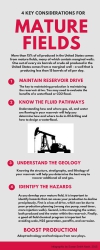Infographics can serve a unique purpose in an online course or training program in that they both engage learners and provide a very handy mnemonic which assists in the storing and retrieving of information.
Infographics are easily incorporated into courses, and can be deployed via social media and within learning management systems. Further, it is a simple process to store your infographic in a cloud-based repository such as SlideShare (slideshare.net) which allows links, embeds to an easily downloaded pdf, along with allowing you to share accompanying notes and information.
For an audio recording, click here.
Here are two examples which were used for the petroleum industry, where it is often challenging to communicate information cogently and without clutter.
Geology vs Engineering Reservoir Realities
http://www.slideshare.net/beyondutopia/geology-and-engineering-mustknow-realities-for-reservoir-development
4 Considerations for Mature Fields
http://www.slideshare.net/beyondutopia/four-key-considerations-for-mature-fields
Working Memory and Infographics
Baddeley and Hitch (1974) described the mechanism used by short-term memory as a process they denoted as “working memory.” In their view, working memory is a process driven by the “central executive” which collects, temporarily stores, and directs data to the cognitive subsystems of the a) visuo-spatial sketch pad, and the b) phonological loop.
As a highly visual artifact with engaging and unique organization of visual information, an infographic is an ideal tool for facilitating the smooth functioning of working memory.
The central executive can easily incorporate a well-designed infographic in the visuo-spatial sketch pad, which is, in essence, the inner eye. The visual spatial sketch pad not only functions in the retrieval process, it also is used in navigation – in locating spatially where information might be.
The central executive takes and replaces information in the visuo-spatial sketch pad, and then relates it to long-term memory. The central executive can move material back from long-term memory to working memory, so the infographic can be used not only to store new information, but as a memory-trigger to retrieve information from long-term memory.
Baddeley emphasized that the central executive also functions as a system to keep attentional processes engaged, and to continually organize and prioritize (McLeod, 2012). It can also relate processes together, so that a infographic that is primarily attached to the visuo-spatial sketch pad, also can be related to the phonological loop processes.
Guidelines for Developing Infographics for Working Memory
1. Keep your information tied to one or two categories
2. Use a clear color scheme
3. Avoid clutter
4. Maintain a minimal main message
5. Connect / refer to details (don’t include all the details in the infographic)
6. Use colors, white space, lively design
7. Use phone, tablet, and laptop-friendly hosting / delivery
8. Make your infographic multi-purpose, reusable
9. Encourage sharing / comments / collaboration
Tools for Building Infographics
Infographics were originally designed almost exclusively by graphic designers, but now there are a number of free and premium services that provide cloud-based services that include professionally designed templates which utilize unique graphics, layouts, and fonts.
Examples include:
Canva (www.canva.com): Templates and unique fonts / images for infographics and presentations.
Piktochart (www.piktochart.com): Templates, images for infographics, reports, presentations
PicMonkey (www.picmonkey.com): Photo-editing that also includes a number of unique fonts, images, and clip art, and easy creation of collages that can also be designed as infographics
Final Thoughts
Infographics can be very practical as well as engaging and fun. For example, if you save them as a pdf files and print them out, you may use the infographics as a point of departure for an impromptu mind map.
The key is to design with an eye to inspiring and triggering thoughts – about the present, past knowledge, and collaborations. Used well, infographics can be an effective tool for deep learning.
References
Baddeley, A. D., & Hitch, G. (1974). Working memory. In G.H. Bower (Ed.), The psychology of learning and motivation: Advances in research and theory (Vol. 8, pp. 47–89). New York: Academic Press.
Baddeley, A. D., & Lieberman, K. (1980). Spatial working memory. ln R. Nickerson. Attention and Performance, VIII. Hillsdale, N): Erlbaum.
McLeod, S. A. (2012). Working Memory. Retrieved from www.simplypsychology.org/working%20memory.htmlwww.simplypsychology.org/working%20memory.html
E-Learning Corgi focuses on distance training and education, from instructional design to e-learning and mobile solutions, and pays attention to psychological, social, and cultural factors. The edublog emphasizes real-world e-learning issues and appropriate uses of emerging technologies. Susan Smith Nash is the Corgi's assistant.
Wednesday, August 12, 2015
Subscribe to:
Posts
(
Atom
)
Blog Archive
- 2023 ( 7 )
- 2022 ( 17 )
- 2021 ( 13 )
- 2020 ( 15 )
- 2019 ( 25 )
- 2018 ( 25 )
- 2017 ( 20 )
- 2016 ( 28 )
- 2014 ( 24 )
- 2013 ( 28 )
- 2012 ( 34 )
- 2011 ( 31 )
- 2010 ( 23 )
- 2009 ( 35 )
-
2008
(
61
)
-
June
(
7
)
- Jun 27 ( 1 )
- Jun 19 ( 1 )
- Jun 17 ( 1 )
- Jun 16 ( 1 )
- Jun 12 ( 1 )
- Jun 09 ( 1 )
- Jun 05 ( 1 )
-
May
(
7
)
- May 26 ( 1 )
- May 22 ( 1 )
- May 15 ( 1 )
- May 11 ( 1 )
- May 09 ( 1 )
- May 05 ( 1 )
- May 01 ( 1 )
-
June
(
7
)
-
2007
(
27
)
-
December
(
13
)
- Dec 27 ( 2 )
- Dec 24 ( 1 )
- Dec 23 ( 1 )
- Dec 19 ( 1 )
- Dec 17 ( 1 )
- Dec 16 ( 1 )
- Dec 10 ( 1 )
- Dec 06 ( 1 )
- Dec 05 ( 2 )
- Dec 03 ( 1 )
- Dec 02 ( 1 )
-
December
(
13
)
- 2006 ( 4 )
- 2005 ( 5 )

